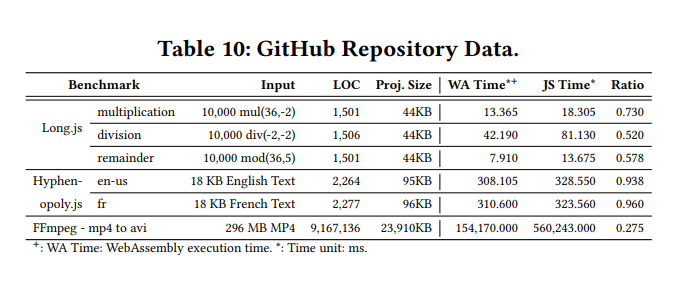
WASM snippets inside JS
WASM snippets inside JS
I believe WebAssembly (WASM) has really been a widely misunderstood technology. When it was first introduced, some people predicted that Javascript is going to die very soon, and few years later you could hear the exact opposite - that WASM doesn’t change anything and it will have no impact on current Javascript ecosystem. If you don’t know what WASM is - the quick unprecise TLDR is that it’s a way to execute languages other than Javascript in the browser (or in node) via WAT.
WebAssembly use cases make it clear that it doesn’t want to replace Javascript, it just wants to empower developers to have an interface to execute code that’s different than Javascript with all it’s benefits and library ecosystems.
So that’s it, right? Unless I want to do some very specific magic I shouldn’t care about this?
I wanted to put that to the test. As a guy who likes both Rust and JS, I think WASM is the only bridge between both of these worlds, and want to know whether looking more into it is worth my while. And if it is, how can I benefit from it?
There’s a lot of very insightful benchmarks, starting with this awesome study of WASM runtimes, this awesome study comparing JS and WASM for different algorithms and ending with Leptos creator talk about WASM frameworks (not to mention HTTP 203 podcast, which also described WASM usages in squoosh).
But I just want to answer few simple questions - if I’m a web developer:
- Should I care about WASM?
- Should I introduce it in my codebase? If yes, how?
- What are the possible gains? Where those would even be?
The setup
First, I think it’s pretty common knowledge that V8 and JavascriptCore can be pretty performant if the task is repetitive, because JIT will do some great optimizations and our potential gains will be severely diminished.
Second, the cost of “crossing the bridge” between WASM and Javascript. There’s a hidden cost in calling WASM - it’s related to browser implementations and the fact that JS encodes strings with UTF-16 while other programming language (including Rust) most commonly encode strings in UTF-8, so there’s a translation layer making string copying between WASM and JS quite costly.
Third, I’m not going to be talking about WASM/JS frameworks and their performance. There’s plenty of benchmarks that frameworks authors do. I’m going to be exploring the idea of calling WASM snippets inside Javascript and whether there’s a performance benefit in doing that. If you’re interested about frameworks, please watch the Leptos creator talk about WASM frameworks - it’s really good and he dives deeper into this topic.
Crossing the WASM bridge
Let’s try to naively compute some prime numbers using Rust (compiled to WASM) and Javascript. We’re gonna use two algorithms
- Unoptimized brute force
- A heavily optimized Sieve of Eratosthenes algorithm (gist).
Brute force JS
export const jsBruteUnoptimized = (upperBound: number) => {
let primesAccumulator = [];
for (let currNum = 1; currNum < upperBound; currNum++) {
let divisibleNums = [];
for (let j = 1; j < currNum; j++) {
if (currNum % j === 0) {
divisibleNums.push(true);
}
}
if (divisibleNums.length === 1) {
primesAccumulator.push(currNum);
}
}
};Brute force Rust (WASM)
pub fn primes_naive_slow(bound: usize) -> Vec<usize> {
let mut primes_accumulator: Vec<usize> = Vec::new();
for curr_num in 1..bound {
let mut divisible_nums: Vec<bool> = Vec::new();
for diviser in 1..curr_num {
if curr_num % diviser == 0 {
divisible_nums.push(true);
}
}
if divisible_nums.len() == 1 {
primes_accumulator.push(curr_num);
}
}
primes_accumulator
}Optimized sieve JS
export const jsPrimeSieve = (upperBound: number) => {
let primes = [];
for (let i = 0; i < upperBound + 1; i++) {
if (i === 2 || (i & 1) !== 0) {
primes.push(true);
continue;
}
primes.push(false);
}
let num = 3;
while (num * num <= upperBound) {
let j = num * num;
while (j <= upperBound) {
primes[j] = false;
j += num;
}
num += 2;
}
primes.shift();
primes = primes
.map((e, i) => {
if (e) {
return i;
} else {
return;
}
})
.filter((e) => e);
};Optimized sieve Rust (WASM)
pub fn primes_sieve(bound: usize) -> Vec<usize> {
let mut primes: Vec<bool> =
(0..bound + 1).map(|num| num == 2 || num & 1 != 0).collect();
let mut num = 3usize;
while num * num <= bound {
let mut j = num * num;
while j <= bound {
primes[j] = false;
j += num;
}
num += 2;
}
primes
.into_iter()
.enumerate()
.skip(2)
.filter_map(|(i, p)| if p { Some(i) } else { None })
.collect::<Vec<usize>>()
}One big calculation
Let’s make a big calculation - finding prime numbers up to 10 000 000 for a sieve, and up to 20 000 for brute force.
A lot of small calculations
Now let’s use the exact same algorithms, but for much smaller numbers executes way more times
- for bruteforce
- prime numbers up to 100, 10 000x times
- for optimized sieve
- prime numbers up to 100, 100 000x times
When you look at those brief results, you’ll see that the JS results are a little bit all over the place. But not for webassembly. It’s incredibly consistent. JS might have a good or a bad day, while webassembly times stay roughly the same.
Another thing you should notice is that WASM is only better if we’re dealing with a big enough single computation, not the frequency of it. That’s because like I mentioned, there’s a certain cost associated with “crossing the bridge” between JS and WASM
Unfortunately for WASM, there’s another hidden cost of it. I’m talking about the bundle size. While the size of Javascript function is negligible, the size of WASM build is 15.1 KiB for those two functions.
Sad truth
Like I mentioned before, I’d like to focus more on potential real-world usages. So before we proceed let’s do a quick thought experiment regarding what those might be:
What performance bottleneck does an average frontend developer deal with? The short answer is - not a lot. In 2023 it’s mostly to do with frameworks, and more specifically - bad usage of them.
Maybe you’ve got a big table to render - that’s a quite heavy task right? Maybe we could use WASM there? Unfortunately, the correct way to approach it is not to render the whole table at once using a more performant language - but to virtualize it.
So, if you wanted to know whether WASM can speed up your React/Svelte/Solid application - unfortunately, that’s not really viable.
But this answer is pretty anticlimatic right? That’s not what we’re here for. Let’s try to find benchmarks (or even benchmark stuff ourselves if possible) for something more computation-intensive, which can still be considered real-world usage.
Quest to find an improvement
Let’s look at tasks that would usually be delegated to the server because they would simply be not fast enough for the frontend.
- FFMPEG video manipulation
- PDF manipulation - it’s pretty common to dynamically create PDFs on the web
FFMPEG
Sadly, there is no pure JS implementation of FFMPEG that is NOT using WASM. There are some very old projects, but it would not be fair to compare them
with more modern implementations. Luckily, if you’re still curious how that benchmark would look like, look no further. I’ve mentioned
this awesome study comparing JS and WASM for different algorithms. Table 10 shows FFMPEG benchmarks.

HTML to PDF
The only two potential libraries are wkhtmltopdf and html2pdf.js. Unfortunately, compiling wkhtmltopdf to WASM would be troublesome as it includes a lot of Qt (trust me, I’ve tried). WASM-pdf could’ve been an okay WASM representative, but it’s pretty barebones, and doesn’t allow for converting HTML to PDF.
So unfortunately there’s no real way to bench these two against each other, as they do quite different things. One creates PDF from HTML, the other one takes an arbitrary JSON as input. The result would not give us a fair assessment of WASM, but the assessment of the approach of each library. Quite dissapointing.
Conclusion
It’s impossible to give a blanket statement whether you should incorporate drop-in WASM snippets. Truth be told, JS is pretty fast these days and has it’s own solutions for any problems that came up over the years. You may gain some performance benefits by incorporating it, but if you so desperately need a faster language in the browser, it seems to me like there’s a bigger chance you might have more major problems with your application.
WASM really seems to be just a way to enable some functionalities. It’s just a way for a browser to be another compile target rather than a fully disconnected platform.
As a javascript engineer you probably don’t need WASM, and if you do - you’ll know it. With that being said, it’s good to be aware of it and what it enables.
PS. I would totally use WASM to build some sick big data dashboards with https://github.com/finos/perspective